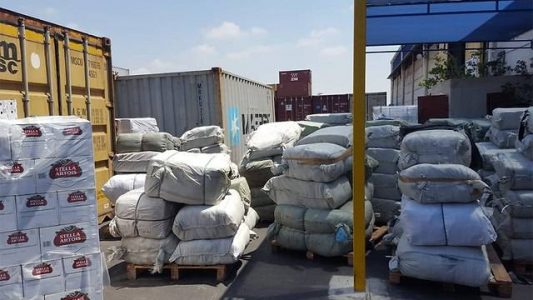
Hamas terrorist group uses humanitarian programs to support terrorism
Israel’s domestic intelligence agency, the Shin Bet, recently exposed a Hamas espionage ring operating in Israel. The ring is part of a wider and more disturbing trend, in which Hamas cynically exploits humanitarian channels to orchestrate terrorist attacks against Israelis.
Hamas is determined to conduct non-stop efforts to pull off mass-casualty attacks against Israelis, and the Israeli defense establishment is constantly thwarting such plots in time, mostly behind the scenes — creating a false impression of security calm.
In actuality, Hamas’s military wing in the Gaza Strip is interested in turning Israel’s streets into scenes of bloodshed and chaos — a dark vision that Israel’s intelligence and security communities work around the clock to prevent.
Hamas’s efforts include bombings, shootings, and kidnappings; the Shin Bet disrupts hundreds of such plots every year.
On Monday, the Shin Bet announced that it had stopped the Hamas spy ring. Two Gazan men, who received Israeli citizenship under a law that reunites families divided between Israel and Palestinian areas, were recruited into the conspiracy. They were ordered to gather information on sensitive targets inside Israel for the purpose of future deadly attacks, according to the Shin Bet investigation.
Yet this pattern of conduct is not isolated. One of the primary tactics chosen by Hamas is to take advantage of humanitarian channels, such as the entry of Gazan medical patients into Israel for hospital treatment.
Hamas in Gaza uses such patients to pass on instructions, funding, and sometimes weapons to terror cells that are forming in the West Bank. Hamas’ military command in the Gaza Strip has a department known as the “West Bank headquarters,” and it is this outfit that is in charge of organizing most such attacks.
The West Bank headquarters’ activities include the 2018 attempt to set up a bomb production center near Hebron, as well as a terror cell that would strike inside Israel, with potential targets including a high profile building, train, bus, or shopping mall. Hamas used a mother of nine from Gaza, who received Israeli approval to accompany her sick sister into Israel for cancer treatment, to deliver messages to the bomb-maker.
Last March, during an escalation with Hamas and Palestinian Islamic Jihad, the Israeli Air Force struck part of a building in Gaza City’s Rimel neighborhood that housed the West Bank headquarters. The IDF described it at the time as the body responsible for directing terrorist attacks, building terror infrastructures, transmitting instructions for terror activities, and transferring money for financing these activities.
In the latest case to be revealed by Israel’s security forces, Hamas’ military wing, the Al-Qassam Brigades, sought out Gazans with Israeli citizenship to exploit their ability to move back and forth between Israel and Gaza.
The Shin Bet arrested two suspects on January 2, naming them as Rami Amoudi, a 30-year-old man who has been living in Tel Aviv since November, and who is originally from Khan Younis in southern Gaza; and Rajab Dakah, 34, originally from Gaza who moved to Israel in 2017.
Amoudi’s mother is Jewish-Israeli, while Dakah’s mother is an Israeli-Arab citizen living in Lod, in central Israel, making both of them eligible for Israeli citizenship through the Family Reunification Law. Dakah left his wife and five children in Gaza to move to Israel, and traveled back to visit them every few months.
The Shin Bet investigation found that the two were recruited by Hamas while they were still in Gaza, and then dispatched to Israel to conduct hostile espionage missions. They were told to purchase cellular phones and SIM cards to maintain secret communications with their Hamas handlers.
Their missions allegedly included photographing a variety of defense installations in central Israel, such as military bases, police facilities, and the locations of Iron Dome air defense batteries, the Shin Bet stated.
They were also ordered to gather information about defense officials, and to relay information about where rockets fired from Gaza last November made impact. The Shin Bet named Matkael Ratzia, 32, from Bet Lahiah in northern Gaza, as a Hamas military operative who recruited and activated Dakah.
Last July, the Shin Bet uncovered an attempt by an explosives expert who was trained by the Hamas military wing to enter Israel through the Erez Crossing.
Fadi Abu al-Sabah, 35, a resident of Nusseirat in the Gaza Strip, was ordered to establish a lab in the West Bank for the production of high powered explosives, which were supposed to be used in bombings to murder Israelis. He received a medical permit from Israel to leave Gaza via Erez, and had training on how to get through Israeli questioning and deny links with his Hamas military wing handlers and trainers, a previous Shin Bet investigation found last year.
And as the Investigative Project on Terrorism reported last March, Hamas is in the habit of siphoning off infrastructure materials that Israel transfers into Gaza for civilian use to build up its terror army.
Pipes meant for waste plants end up as rocket bodies that are aimed at Israeli cities. Generators intended for civilians end up in underground terror tunnels, powering lights and other electric needs, and medical oxygen tanks earmarked for hospitals go to tunnel diggers. Hamas also regularly exploits Gaza’s civilian mail system to try to import dual use equipment that has both civilian and military purposes to build up its attack capabilities. Those shipments include chemicals that fuel rockets, generators for tunnel digging, drones, digital microscopes, biometric equipment, cell phones designed for rugged field conditions, and fiberoptic cables.
There is little reason to believe that Hamas’ well established pattern of taking advantage of humanitarian openings to promote terrorism will change any time soon. Israel’s security forces will continue to be on high alert for such dangerous activities, while remaining committed to the goal of assisting Gaza’s civilians where possible, despite Hamas’ activities.
Source: Algemeiner





